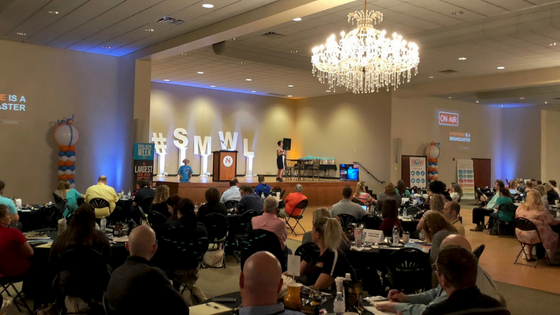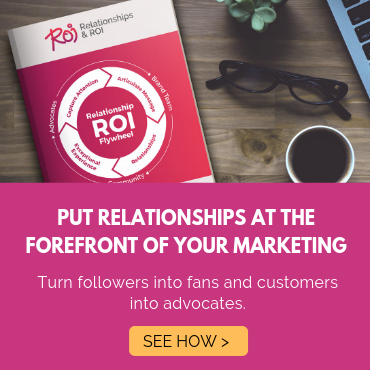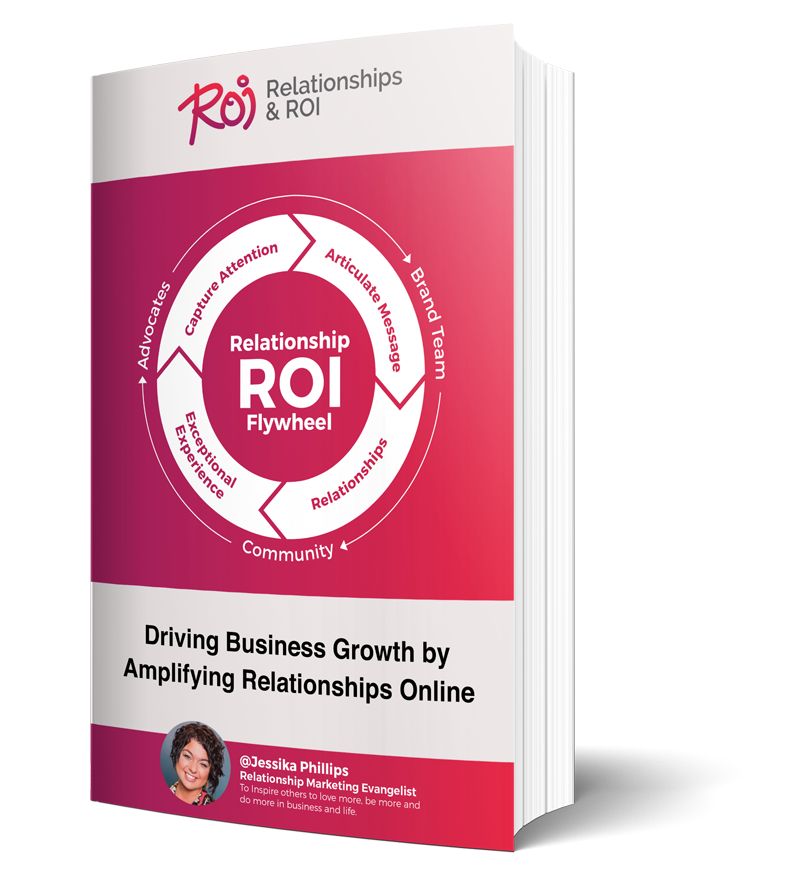Our Social Media Week Lima conference was held June 20 and 21 in Lima, Ohio
Every year, NOW Marketing Group hosts Social Media Week Lima (#SMWL18). What started in 2012 as a small gathering in our office has turned into a high-energy conference with more than 200 attendees. Our focus is always to use relationship marketing to build online relationships and grow organic traffic to businesses. With this in mind, our annual conference aims to teach area business owners and marketing professionals how to use specific tools to grow their organizations.
This year, we explored what it means to be human in a digital world (what we called the #HXPerence) and how you can use those human experiences to build a connection with your online audience.
Our speakers covered topics from social media to best business practices to email campaigns. With two days jam-packed with sessions, there was a lot of knowledge being served to our audience. Here are just a few highlights from our speakers and what knowledge bombs they shared with us:
Day One
Jessika Phillips – Welcome to the Human Experience
@JessikaPhillips
Our keynote speaker was our very own Jessika Phillips, who spoke about how attendees could grow their brand using relationship marketing.
Her method is to CARE for audiences:
- C- Capture their attention
- A- Articulate the message
- R- Relationship-Focused
- E- Exceptional Experiences
The first thing she said is to capture the attention of your ideal customer. But attention is more than views, Jessika said, it’s getting permission from the audience. Once the audience gives you permission, they are more likely to pay attention to you. Jessika also said we need to figure out who we are trying to connect to.
She said you also need to articulate your message and answer their questions. A majority 77 percent of brand conversations on social media are people looking for advice, information, or help [Mention]. You should aim to be the one that answered their question and solved their problem.
Make your marketing all about the audience. People think in stories. So make your story unique to your brand and the experience you’re trying to create online.
Jessika said that relationships help drive repeat and referral business. That’s because when people love working with you they will insist their friends do business with you too.
“Attention is more than views. It’s permission.” – Jessika Phillips
People are going to talk on social media regardless of if you’re part of the conversation or not. So join in, Jessika said! Personalize your content to your audience and make it something extra special. Afterall, the best marketing doesn't feel like marketing.
Jessika also said that we need to create exceptional customer experiences and ensure our information is accurate. Respond to requests online in a timely manner. And that at the end of the day, relationships are the greatest currency in business.
Tweetables: "Relationships are the greatest currency in business" -Jessika Phillips
You don't need more tools, you need a better technique.
Stop counting likes and start counting conversations.
Brian Fanzo – Omni-Sensory Experiences are the Future of Digital Marketing
@iSocialFanz
Brian Fanzo’s presentation introduced us to the topic of omni-sensory experiences and how we can use them in our marketing to connect with audiences and build empathy.
He said that we are moving to a new reality of experiences online, and the reason for this is that we want to embrace our humanness online and find new ways to connect. There are many ways to do this and multiple platforms to choose from. For example, he said our audiences don’t care what email platform you use, just that you use it and it works. It’s the combination of human plus machine that equals human experience online.
“Perfection is a fairytale, control is an illusion.” – Brian Fanzo
He also said we don’t need to wait around for content or videos to be perfect. Instead, we just need to push the button and do it.
His tip to creating content was to create omni-content. For example, if you create a blog turn it into a video, then rip the audio and turn it into a podcast.
Brian said that you can no longer just build a website and an audience will appear. Instead, your content has to go where your audience is. If you give them access to your content on the specific channels they follow, you can build a connection. Use social media to shrink the distance, Brian said.
Angus Nelson – Honing your humanity: New Marketing Strategies to Create Brand Influence
@AngusNelson
First and foremost, Angus Nelson said you have to have a target to have a return on intention. So, figure out who you are trying to target!
Go deep to go high. Don’t focus on everywhere or everyone. Find the core audience who is using your product. Who is your community? Think snowballs, not snowflakes, and go deep into their culture, language, and experience. Collaborate with them to build your brand.
Next, you have to realize that your brand isn’t the hero. You are Yoda– make your customer Luke Skywalker. He also said to think people before product. The customer is the focal point of everything. Get their feedback and use their words. You can even use it for your copy and in your content.
“You are Yoda– make your customer Luke Skywalker.” – Angus Nelson
Angus also suggested thinking like a movement, not marketing. You need to stand for the same things as your audience. What’s the manifesto for your brand?
Lastly, what are the stories your customers are telling? Can you create a Facebook group for your audience that gives them an outlet and lets them talk?
Demian Ross – Analog Marketing: Bringing the Human Back in Human Connections
@DemianRoss
Demian Ross spoke to our audience about how old-school marketing, or what he calls analog marketing, can be used to build personal relationships.
When it comes to creating video and content, he said that you can have all the gear you want, but don’t be afraid of just starting with what you have. What you have in your hand is easiest. So just do it. Demian also said not to care about followers, view counts, or shares. Just begin to create content. People will start to pay attention.
Demian also talked about how there is an analog and digital disconnect. While the majority of us have moved onto social media and online interactions, there is still value in meeting for coffee or sending personalized gifts when appropriate.
Tiffany Lanier – Humanizing Video with Your Personal Brand
@LivewithTiffany
Tiffany Lanier helped attendees define their personal brand, how they can use their skills, experience, and interest to create video content that will draw in an ideal audience, and how they can use a video strategy to help their personal brand flourish.
She said that social media has allowed us to become the publication, publicist, the cameraman, and the photographer. Your brand needs to come from your core, Tiffany said, from your passion and interests and how those match up with your skills and experience.
She said to:
- Value Your Knowledge (self-Confidence)
- Determine the Value of Your Content (Benefit)
- Remember the Value in Consistency (Relationship)
Feeling good about what you do is important. So, Tiffany recommended using video in a way that is meaningful, fun, and compelling.
“The value isn’t only in the content you create, it’s also in the authentic approach to the content” – Tiffany Lanier
You can use video in multiple ways now, with Live video on social media, Stories, and pre-recorded videos.
Ultimately, Tiffany said to build your brand from knowing yourself, being true to yourself, knowing who your audience is, and tell your story on the video platform that works for you.
Cathy Hackl – Augment Your Brand: Integrating AR into your Marketing Strategy
@CathyHackl
Cathy Hackl spoke to us about the future of marketing and how her company uses new technologies to bring immersive experiences to customers online. Artificial reality, virtual reality, and artificial intelligence are all the future of media and content consumption, she said. In fact, every major tech company is pouring money into these technologies to bring them to the mainstream. There are a couple different new technologies that will be increasingly prevalent in the next few years.
These include:
- Augmented reality apps– These apps can allow place customers to virtually place things in their home. Ikea and carpeting companies are already using these technologies. With it, customers can see exactly what a product would look like in their home before they buy it and bring it home. For Ikea, this helped reduce returns.
- Augmented reality printed media– This technology changes how people can experience physical items in front of them. Printed media has a trigger that people can play on their phone to view an augmented reality. For example, the 19 Crimes brand of wine has augmented reality printed media on the label.
- AR integrated into social media– These can be like Lenses in Snapchat and Instagram. It’s augmented reality within a social media platform.
- Immersive screens– These screens can be found in the real-world (typically they are larger screens) that make the appearance of a virtual reality through the screen. They have been used in viral marketing campaigns.
VR and AR will also be used to “gamify” work and turn it into play, e.g. turning packaging and logistics sorting into a game of Tetris.
Cathy stressed that this is the future. Very soon we will be using these technologies, including the AR cloud which is digital data that will be the next computing platform. Essentially, our world will be painted with data.
We need to be ready for these technologies and use them to connect with audiences through our marketing.
Bryan Kramer – How to Humanize Your Business
@BryanKramer
Bryan Kramer talked about how we can use technology without losing the human element that sets us apart. One of the ways you can do that is to acknowledge your errors (when you make them), and use some humor if you can!
He also reminded attendees that machines can’t respond to customers like humans can. So while ChatBots and artificial intelligence have their place, a human can always communicate better. We can personalize and improvise. A machine can’t.
Bryan also said that the human economy is the dichotomy of personalization and automatization. Remember to use personalization to communicate with your audience while incorporating automation to reach more people more easily.
He also said to go the extra step and deliver something extra that they need (that’s over the top).
Mia Voss – How to Build a Strong Community/Tribe Online and in person AKA: How to Not Transact Like an Asshat
@MiaVossOnTheGo
Mia Voss talked about how we build a strong community online by interacting with followers at a higher level.
She said that when you transact at this higher level, you can show others how to work with you,
elevating your surroundings so everyone plays nicely in the sandbox.
To get a perfect community, you need to romance your connections, connect with them on all social platforms, and engage with their content. We need to stop trying to get to second base right away, she said.
Mia said the things that people like are consistency, gratitude, giving more and taking less, and feeling valued.
Day Two
Ashley Thompson – Putting your Marketing Plan into Action
@Be50Strong
As a local business owner, Ashley Thompson had some great insight on how attendees could use marketing to build their brand. She said that anyone can be a great marketer with no formal education required. Resources are everywhere and you simply need to believe in you.
She stressed that as a company, you know your business better than anyone else. Own that, Ashley said. If that’s not true, you need to STOP! Learn all about your industry. Know your market, know your competitors, know your audience. OWN that knowledge and use it to develop a plan that is perfect for YOUR business. Once you’ve been at it awhile, re-evaluate your plan! Things change, sometimes your marketing needs to change too.
“You know your business better than anyone else – OWN THAT!” – Ashley Thompson
Ashley also said there are no concrete rules in marketing. All you need to do is be nice and keep showing up.
Christian Betlyon – Conversation is the Ultimate Brand Building Strategy
@CBetlyon
Christian Betlyon spent his session exploring some of the deeper psychologies behind marketing and how businesses can tap into them to create meaningful conversation online.
Christian said that while branding is the oldest form of marketing, it’s never been more vital. Furthermore, brand awareness always has, and always will, provide an advantage.
Brand awareness is related to memory, and Christian explained how these memories are created, including long-term and short-term. More than anything, Christian said, humans remember strong emotions. The brain responds strongly to things out of the ordinary. Therefore, we can use strong emotion to evoke a response and ultimately be remembered.
Christian also spoke about the current trends in digital marketing, which is, according to him, broken. Digital marketing is consumed by a focus on lead generation and cost per acquisition, not conversation. Brand awareness metrics are vanity-based. Media is treated as a monologue, not a conversation.
Instead, he said, marketing needs to focus on conversation and on building the brand. We need to be consistent and responsive online. It will take time to build your brand and you need to be adaptive and learn. Know your role, he said.
Tools he recommended to help find conversation include Twitter Advanced Search and Adwords Keyword Planner.
Mike Allton – The Blogger’s Mindset: How To Create 10X Content 10X Faster
@Mike_Allton
Mike Allton said that everyone writing blogs needs to think first about a critical question: who is your blog for? Before you begin to create any blogs, first you need to focus on the stuff your personas care about and the things that are directly related to your brand. He said to choose a narrow niche and never to waste time creating content that doesn’t relate to the story, brand, and product.
He also recommended everyone use analytics to confirm that they were creating the right content. Page views and time spent on a page will be good indicators as well as likes and shares on social media.
Mike also said to elevate the quality of the content you create, and once or twice a year to create long-form blogs with detailed and specific information. These should be more than 2,500 words.
Keep a system in place to write down notes, he said, someplace different than where the writing happens. Evernote is a good option.
Mike said you can also use the news as a way to create content. If there is breaking news related to your industry, write about it as it is happening and keep adding information as it is available.
Bella Vasta – How to Rock your Facebook Group Into a 6-Figure Business
@Bellas_Pets
Bella Vasta introduced her topic by explaining Maslow's Hierarchy of Needs. One of the needs is, of course, love and belonging, which she said was critical in leading Facebook groups.
Using a poignant story of her own struggle, she explained how people often use Facebook groups to find love and belonging in times of need. Facebook groups, she said, are the epitome of the humanized experience on social media.
There are groups that are:
- A Niche of a Niche
- Talk About Unique Challenges
- Have a Captive Audience
- Are Intimate
- Use Special Rules
- Are Exclusive
And some groups are:
- Large
- All Levels
- General
- Not Intimate
- Still a Place of Belonging
Bella said to make a profit using Facebook groups, you have to: nurture relationships, use targeted Facebook ads, go live or use video, and build a list of emails.
But you also need to offer the community some value. Ask yourself what can you offer them (with a feeling of love and belonging), how can I use them as testers or pre-launch, what can I create for my community, and how can I leverage my community?
Your audience will tell you what they want to hear, so just listen. Let people feel a sense of belonging and you can generate six figures!
Jeff DeHaven – Instagram Stories Deep Dive
@JeffDehaven
Once again exploring the topic of video, Jeff DeHaven gave his presentation on Stories. Stories are used by some of the top social media networks: Facebook, Instagram, and Snapchat. Jeff told us some of his top tricks to using this form of video to get engagement with viewers.
First off, he said that Facebook is the main social media network, with more than two billion users a day. Next is Instagram with more than 700 million monthly users. Two times larger than Twitter, it has more daily users than SnapChat.
The first best practice, Jeff said, was to stop joint publishing. It’s important to have a separate strategy for Instagram. The two networks are different and are focused on two different things.
The next thing to keep in mind is attention span. Stories are quick, fast-moving pieces of video content. While they may be brief, the average attention span is only eight seconds long. Therefore, Jeff suggests people do six-second Stories.
Both of these platforms also allow Live videos. Live videos get more exposure and more interactions than any other type. But, Jeff said, you need to go live with a purpose. He suggested people promote your Live videos with stories.




Comments